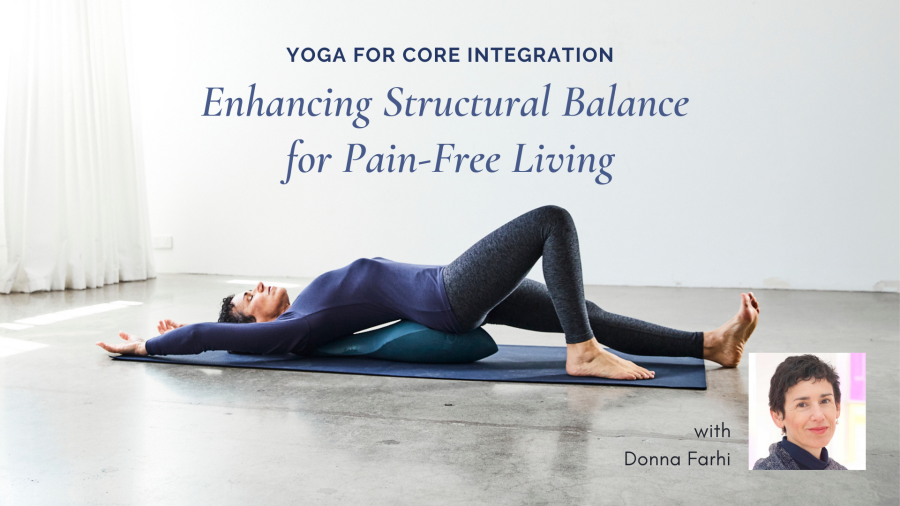Yoga for Core Integration - Enhancing Structural Balance for Pain-Free Living
Course Info
- Price:
- $397.00
Donna Farhi
 Donna Farhi is a yoga teacher who has been practicing for 39 years and teaching since 1982. She is one of the most sought after guest teachers in the world, leading intensives and teacher training programs internationally. Her approach to yoga is informed by the refinement of natural and universal...
Donna Farhi is a yoga teacher who has been practicing for 39 years and teaching since 1982. She is one of the most sought after guest teachers in the world, leading intensives and teacher training programs internationally. Her approach to yoga is informed by the refinement of natural and universal... 
Everything that we do in our everyday lives is dependent on our posture. Our ability to lie down, sit, stand, and walk in comfort is directly related to the template of centered body posture. Every Yoga posture or athletic activity is an expression of the clarity and refinement of this most basic relationship of our body structure to the ground, gravity, and space. As Yoga teachers, posture is where we begin and what we repeatedly return to, to help students resolve issues such as limitations in movement and spinal discomfort. Yet how many of us have deep, seemingly unchanging structural “snags” in our body that throw us off balance despite years of yoga practice?
Drawn from decades of teaching experience and her recent collaboration to write Pathways to a Centered Body with coauthor Leila Stuart, this workshop will be an invaluable investment for yoga students and for teachers of all movement disciplines who wish to offer effective and pain-free strategies for improving body alignment, movement function and healing back pain.
The first sessions in the series will focus on the psoas and its important role in structural integrity. You will learn how to both identify and correct deep structural imbalances in your body that may be preventing you, and your students, from being truly centered.
The second part of this series focuses on the core cylinder and how it can be developed to improve structural integrity.
Part 1: Yoga for Core Integration: Balancing the Psoas for Lifelong Back Health
In the lecture sessions, Donna will unravel the complexities of the deepest core muscles of the body, the psoas, to reveal its function as an extraordinary unifying structure for the entire body. When these deep core muscles become unbalanced, the position of the pelvis and spine is thrown off-center.
Poor posture, back pain, and discomfort and restriction in movement can result. Working with a therapeutic protocol, you will learn extraordinarily effective techniques to soften, hydrate, and release and lengthen the psoas muscles. Using these techniques you can help your students address seemingly intransigent conditions such as hyperlordosis (accentuation of the lumbar curvature) and alleviate pain caused by sacroiliac and lower back compression.
Video Tutorial One: Softening and Hydrating the Psoas and Spinal Muscles 
Learning to release the psoas and spinal muscles begins in Constructive Rest Position (CRP)– a very specific supine practice that can alleviate compression in the lumbar spine and release pressure in the sacroiliac joint. Donna will show five different variations of this position for addressing conditions such as inflammation, hyperlordosis (accentuation of the lumbar curvature), sacroiliac instability, and more specific spinal pathologies such as spondylolisthesis (forward shift of the lumbar vertebrae). Many students have relayed that practicing CRP for 15 minutes twice a day has resulted in more dramatic improvement of chronic pain and discomfort than more active practices. This section of the tutorial will give you a toolbox for helping students who previously could not lie comfortably with the legs straight to find a restful relaxation position.
You’ll then learn a basic tracing technique to heighten awareness of the pathway of the psoas muscles followed by a pulsation technique for hydrating and softening the psoas and spinal muscles. Following this, Donna will lead you through a spiralic warm-up technique that prepares the spine for deeper ranges of movement. You’ll finish the tutorial by learning the first of many techniques that incorporate a muscle release ball, a simple, low-cost, pain-free and incredibly effective technique for paving the way toward a happy psoas.
Video Tutorial Two: Release and Lengthen the Psoas Muscles
Many techniques that purport to release the psoas muscles are unnecessarily painful and often result in further defensive holding in these deep core muscles. In this tutorial you’ll learn a series of gentle techniques to release and lengthen the psoas muscles. Techniques offered include those that can be practiced independently or with the assistance of a sensitive partner, incorporating simple props such as a towel, Muscle Release Ball, bolster, or chair. You can cherry pick these techniques to use one or two practices within a yoga class. Or you can use the techniques as part of a targeted therapeutic protocol to resolve deep core imbalances that may be contributing to spinal and pelvic discomfort.
Part 2: Yoga for Core Integration: Resolving Structural Imbalances in the Core Body
Donna will introduce you in her uniquely engaging way, to the “secondary core muscles” of the body; the thoracic and pelvic diaphragm, multifidus, and transverse abdominis. How do these muscles coordinate with the medium of the psoas to provide core stability?
You’ll learn how engaging thoraco-diaphragmatic breathing is crucial to core stability and how the use of ideokinetic imagery can help to “switch-on” the core body. Drawing on this material, you’ll learn how to safely improve your flexibility in yoga practices without compromising pelvic and spinal stability.
Video Tutorial: Balancing and Strengthening the Core Body
Almost everyone has slight differences between the two sides of their body. For some people these asymmetries will be the cause of one-sided discomfort, pain, and movement dysfunction. In this tutorial you’ll learn gentle somatic release techniques that specifically address imbalance in quadratus lumborum (psoas major’s neighbor and partner in crime), as well as supported assymetrical spinal traction work. You’ll conclude the session with a self-care osteopathic technique - The Pelvic Reset - that can be used at the beginning or end of any session to realign and stabilize the pelvis. Finally, in preparation for the next tutorial you’ll learn how to kick-start Thoraco-Diaphragmatic breathing as a support for core stabilization and the importance of distinguishing this Abdominal Breathing.
Video Tutorial: Practicing Yoga with Core Awareness
Learning to shift the focus from “how far, how much,” to practicing with a stable core is the beginning of learning the deeper purpose of yoga practice: to quieten the mind and cultivate physical, mental and emotional steadiness. In this tutorial Donna will begin with a simple core strengthening series, followed by a therapeutic approach to increasing hip mobility while simultaneously securing pelvic stability. Sharing a powerful ideokinetic imagery practice that helps to switch on the deep core muscles, Donna will then lead you through some basic yoga postures and sequences finishing with a “back-to-center” Savasana.
This Premium Course Also Includes:
-
Recordings of All Webinar Sessions: It’s generally acknowledged that many people only retain 10-20 percent of what they learn in a workshop. You will get access to the recordings of all webinar sessions - both MP3 (downloadable) and MP4 (streaming online), enabling you to go back and listen to the workshop as many times as you like.
-
Transcripts of All Sessions: Ever wanted to refer to a certain part of a course? Even the best note takers miss a point every so often. With the transcripts of the sessions, you can go back and refer to particularly important passages or clarify sections you were in doubt about.
“I came with no expectations – only experience of past workshops with other accomplished teachers who mostly structured the lessons around asana. In contrast, this blitzed all!! Donna is a master presenter and educator. The information given, powerful and instantly useful, delivered in a well measured series for ease of understanding.” ~ Adrienne Lewsam
“Donna’s work is of the highest integrity, cohesion and value I have ever found in 37 years of my Yoga path. Simply the best of the best.” ~ Carol Stall
“Donna’s teaching has greatly increased my understanding of biomechanics and human movement, taking the concepts far beyond standard health science textbooks. Applying this knowledge to yoga creates a profound awareness of subtle changes and possibilities within the human body and spirit. I am looking forward to integrating this with my studies in yoga, remedial massage and mind-body medicine. Above all, I really appreciated Donna’s grounded, practical approach to yoga and teaching.” ~Kelly Elizabeth Fox, Australia
“Donna’s in-depth knowledge of the spinal column is outstanding. The intelligence of the information is remarkable. Donna helped me bring my awareness internally to a level that I have not previously experienced.” ~ Lilly Markaic
This course qualifies for 9 non-contact hour CEs with Yoga Alliance.